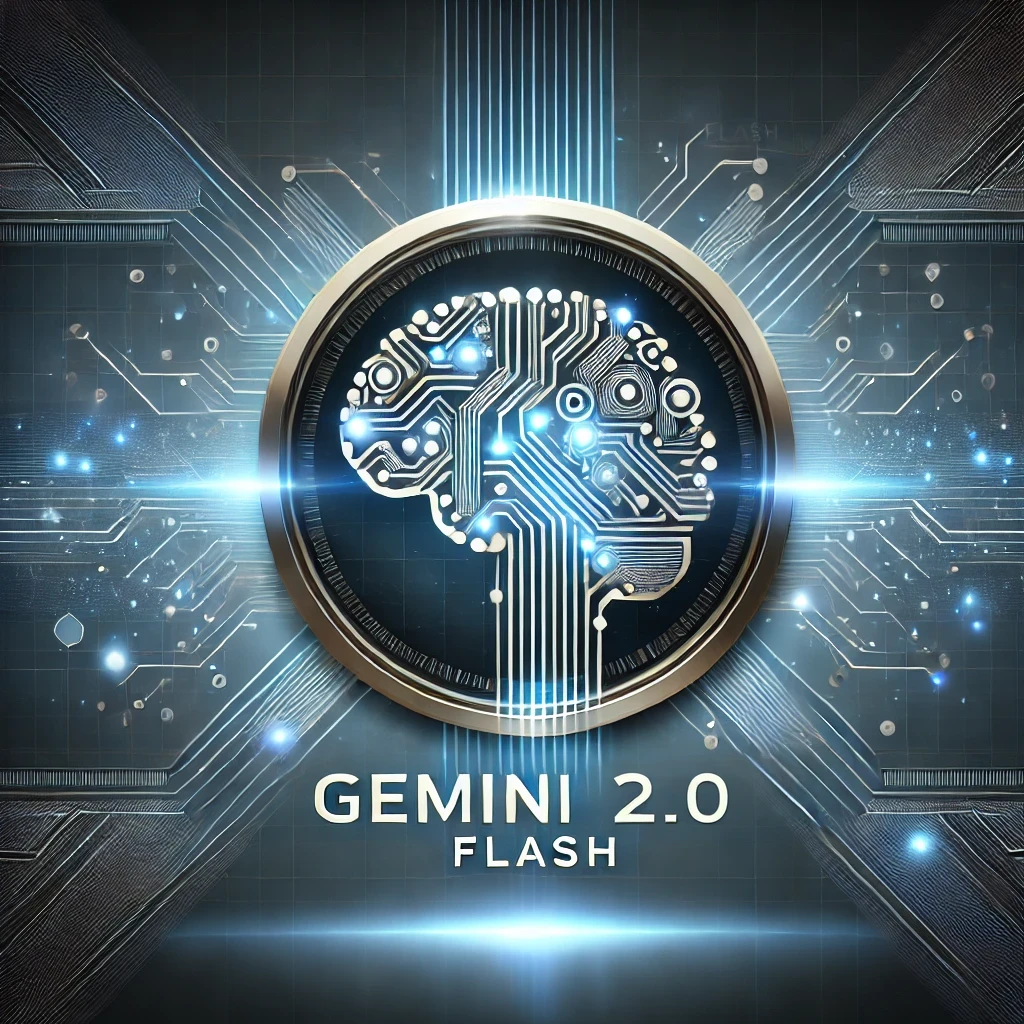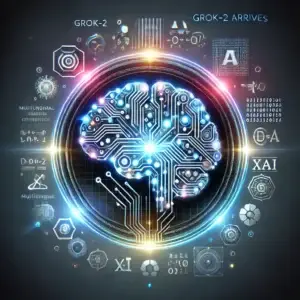Introduction to Gemini 2.0 Flash Thinking
The rapid evolution of artificial intelligence (AI) has led to the introduction of innovative models aimed at enhancing reasoning capabilities. One such model is Google’s Gemini 2.0 Flash Thinking, which represents a significant advancement in the AI landscape. This new framework has been developed to tackle the complexities associated with reasoning and problem-solving, particularly in multifaceted scenarios that traditional models often struggle to navigate.
At its core, Gemini 2.0 Flash Thinking focuses on improving the ability of AI to process information rapidly and make informed decisions. By leveraging a more sophisticated architecture, this model aims to mimic human-like reasoning processes, enabling machines to analyze situations and derive conclusions effectively. This ambitious goal addresses a critical need within the AI community: the ability to apply logic and reasoning to varied tasks, a skill essential for numerous applications ranging from natural language processing to advanced decision making.
Furthermore, the introduction of Gemini 2.0 Flash Thinking signifies Google’s commitment to innovation in AI technology. It is designed not just to enhance existing capabilities but also to redefine the benchmarks for performance in reasoning tasks. As AI becomes increasingly integrated into various sectors, including healthcare, finance, and customer service, the need for reliable and efficient reasoning models becomes paramount. Gemini 2.0 seeks to fulfill this demand by providing robust solutions that can adapt to complex challenges, thus positioning itself as a pivotal player in the ongoing AI revolution.
In outlining the significance of this model, it is crucial to consider how its features and performance will shape the future of AI reasoning. The following sections will delve deeper into these aspects, exploring the transformative potential of Gemini 2.0 Flash Thinking.
The Thought Process Behind Gemini 2.0

Gemini 2.0 introduces a groundbreaking approach in the realm of artificial intelligence reasoning. Central to this model is its ability to engage in a systematic thought process when addressing complex questions. Unlike traditional AI systems that may provide surface-level responses or rely heavily on pattern recognition, Gemini 2.0 enhances its reasoning capabilities by breaking down complex problems into a series of manageable, logical steps. This structured methodology ensures that each component of a query is thoroughly analyzed before arriving at a conclusion.
This explicit thought process is facilitated by an innovative framework that allows the model to articulate its reasoning transparently. By laying out the individual steps involved in solving a problem, Gemini 2.0 can effectively communicate the rationale behind its answers. This transparency not only fosters user trust but also makes it easier for users to understand the logic the AI employs, thus differentiating it from other models that may lack this level of clarity.
Moreover, the step-by-step breakdown utilized by Gemini 2.0 exemplifies its capacity for higher-order reasoning. It enables the model to tackle multifaceted questions by isolating key components, weighing their significance, and then synthesizing a coherent response. This approach mirrors human cognitive processes, making interactions with the AI more intuitive and relatable. As such, users can expect responses that are not only more accurate but also easier to follow, a significant enhancement over previous iterations of AI reasoning.
In sum, Gemini 2.0’s unique thought process allows it to distinguish itself in the competitive landscape of AI reasoning technologies, setting a precedent for future developments in this domain.
Demonstrating Gemini 2.0: A Case Study in Physics
The recent advancements in artificial intelligence (AI) have ushered in a new chapter in computational reasoning, particularly highlighted by the introduction of Google Gemini 2.0. To showcase the model’s capabilities, we turn to a detailed case study focusing on its application in solving physics problems, expertly conducted by AI expert Jeff Dean. This case study exemplifies how Gemini 2.0 engages with complex scenarios, revealing its nuanced understanding of physics principles.
The methodology employed in this demonstration involves presenting Gemini 2.0 with a range of physics problems, spanning topics such as kinematics, thermodynamics, and electromagnetism. Initially, the model is tasked with interpreting the given problem statement, requiring it to identify relevant physical laws and entities involved. For instance, if presented with a question regarding projectile motion, Gemini 2.0 assesses the parameters such as launch angle, initial velocity, and gravitational forces.
As the solution process unfolds, Gemini 2.0 substantiates its reasoning by methodically working through each mathematical formula and calculation. This step-by-step evaluation not only elucidates the physics concepts but also allows observers to trace the logic applied by the AI. In doing so, the model leverages learned patterns from extensive datasets which include both theoretical explanations and practical applications.
The effectiveness of Gemini 2.0 is further evidenced by its capability to draw connections between various physics concepts, exemplifying an interdisciplinary approach to problem-solving. The interactions between different physical phenomena are distilled into coherent explanations that can be understood by users with varying levels of expertise. Such an ability signifies a significant leap in AI reasoning capabilities, establishing Gemini 2.0 as a powerful tool in educational environments and research.
In conclusion, this case study not only highlights the functionality of Google Gemini 2.0 in addressing physics problems but also emphasizes its reasoning capabilities, setting a new standard for AI-driven computation in educational settings and beyond.
Visual and Textual Integration: A New Frontier
Google’s Gemini 2.0 represents a significant advancement in artificial intelligence, particularly through its capacity for combining visual and textual information. This integration allows the model to address complex problems that involve multiple forms of data, enhancing its problem-solving capabilities across diverse applications. Logan Kilpatrick, a prominent figure in AI development, highlights how this dual processing ability expands the utility of Gemini 2.0 in various fields, from education to healthcare, and beyond.
The model processes visual inputs, such as images and videos, and seamlessly combines them with textual data to generate comprehensive analyses and insights. This capability is especially beneficial in environments where context is paramount; for example, in medical imaging, Gemini 2.0 can analyze visual data from scans in conjunction with patient reports, thereby improving diagnostic accuracy and efficiency.
Moreover, the implications of Gemini 2.0’s visual and textual integration extend to the realms of accessibility and user experience. By enabling users to interact with data more intuitively, the model simplifies the complexities often associated with data interpretation. This is particularly evident in educational settings, where students can engage with material that integrates visual aids and descriptive text that enhance comprehension and retention.
In real-world applications, Gemini 2.0’s feature facilitates a deeper understanding of context and nuance. For professionals in fields such as marketing, the AI can analyze customer behaviors through both visual cues from social media and textual feedback from reviews, allowing for more targeted strategies. Hence, the ability to synthesize different information types significantly cultivates an environment where better-informed decisions can be made.
Comparing Gemini 2.0 with OpenAI’s O1 Model
The advancements in artificial intelligence have led to the development of various models designed to enhance reasoning capabilities, among which Gemini 2.0 Flash Thinking and OpenAI’s O1 model stand out. Both models exhibit unique strengths and weaknesses, particularly when it comes to complex reasoning tasks.
Gemini 2.0 introduces a multifaceted approach to reasoning, incorporating innovative techniques that allow it to process and analyze information dynamically. This model’s architecture is optimized for context sensitivity, enabling it to handle intricate scenarios with a higher degree of proficiency compared to its predecessors. For instance, in tasks that require multi-step reasoning and the synthesis of diverse data points, Gemini 2.0 often outperforms OpenAI’s O1 model, providing users with clearer insights and more cogent responses.
On the other hand, OpenAI’s O1 model, while robust in its language processing capabilities, tends to face limitations in managing more convoluted reasoning tasks. Its strength lies in generating contextual narratives and engaging conversational responses. However, when required to extrapolate complex relationships or navigate ambiguous topics, it may not consistently deliver the depth of analysis that Gemini 2.0 provides. Additionally, Gemini 2.0’s integration of a wide array of data sources enhances its flexibility and adaptability, making it an attractive option for developers focusing on applications demanding sophisticated reasoning.
In terms of user implications, those seeking to leverage AI for tasks involving deep analytical reasoning may find Gemini 2.0 to be more suitable. Meanwhile, developers focusing on engaging dialogue systems may prefer OpenAI’s O1 model, acknowledging its strengths in user interaction. Ultimately, the choice between Gemini 2.0 and O1 will depend on the specific requirements of the project, making it essential to evaluate both models against the intended application.
The Current Limitations of Gemini 2.0
While Gemini 2.0 represents a significant advancement in AI reasoning capabilities, it is essential to identify the boundaries of its current functionality. Despite its potential, there are several limitations that impact the model’s performance in reasoning and problem-solving contexts. One primary challenge lies in Gemini 2.0’s ability to understand nuanced contexts. Although it excels at processing information, the model sometimes struggles with recognizing subtle cues that might alter the meaning of a query or instruction, leading to responses that may not fully align with user intent.
Another notable limitation pertains to its capacity for abstract reasoning. Gemini 2.0 primarily operates on patterns derived from extensive datasets, which can hinder its ability to engage in complex logical thinking or to draw inferences that require advanced cognitive reasoning. This limitation is particularly evident in scenarios that necessitate multi-step problem-solving or creative thinking. As a result, users may encounter situations where Gemini 2.0’s answers lack depth or fail to adequately address the intricacies of a problem.
Furthermore, Gemini 2.0 occasionally exhibits difficulties in managing contradictory information. In environments where it encounters conflicting data, the model can become confused or provide inconsistent outputs. This inconsistency can undermine user trust in the model’s responses, particularly in critical applications where accuracy is paramount. Lastly, while the AI model leverages machine learning to improve, it still requires extensive training and updates to enhance its reasoning capabilities continuously. This ongoing development signifies that, while Gemini 2.0 has made impressive strides, there remain crucial areas for growth that could better facilitate effective reasoning and problem-solving in future iterations.
Developer Access and Experimentation
The introduction of Google Gemini 2.0 Flash Thinking represents a significant advancement in artificial intelligence technology, particularly in the realms of reasoning and learning capabilities. To facilitate the utilization of this cutting-edge model, Google has made it accessible to developers through its AI Studio platform. This initiative offers an exciting opportunity for developers to engage with Gemini 2.0 and explore its diverse functionalities. By providing access to this innovative technology, Google encourages an environment ripe for experimentation and creative development.
Developers can register for access to AI Studio, which serves as the gateway for interacting with the Gemini 2.0 model. The platform is designed to be user-friendly, allowing developers to seamlessly integrate their existing projects with the advanced capabilities offered by Gemini 2.0. Essential tools and resources are made available within AI Studio, helping developers harness the full potential of this AI reasoning technology. They can perform trials, conduct experiments, and implement new features that can enhance user experiences across various applications.
The ability to access and experiment with Gemini 2.0 also fosters collaboration within the developer community. As developers share their findings and innovations, a collaborative spirit emerges, paving the way for collective growth and advancement. This process not only enhances individual projects but also contributes to the overarching evolution of AI technology. By actively participating in this experimentation phase, developers can share insights into the model’s application, uncover challenges, and propose enhancements. Ultimately, the access provided by Google Gemini 2.0 Flash Thinking empowers developers to push the boundaries of what is possible within the AI landscape.
Future Implications of Gemini 2.0 in AI Development
The introduction of Google Gemini 2.0 marks a significant milestone in the evolution of artificial intelligence (AI) systems, particularly in the realm of AI reasoning. As AI technologies continue to evolve, the implications of Gemini 2.0 can be manifold, affecting not only technical advancements but also the competitive landscape of various AI models. The unique capabilities of Gemini 2.0, such as enhanced reasoning abilities and context-aware processing, could drive the development of more sophisticated AI applications that deliver improved performance across a range of tasks.
One of the most notable potential outcomes is the elevation of AI reasoning quality. With Gemini 2.0’s innovative architecture, future AI models could benefit from a more nuanced understanding of context and user intent. This enhanced reasoning capability may facilitate advancements in areas such as natural language processing, computer vision, and even ethical considerations in decision-making processes. As AI becomes increasingly integrated into everyday applications, these improvements promise to enhance user experience and broaden the scope of viable applications.
Furthermore, the emergence of Gemini 2.0 will likely alter the competitive dynamics among AI providers. Companies focusing on traditional AI models may need to adapt their strategies to leverage the advancements introduced by Gemini 2.0 or risk falling behind. This could lead to an increased emphasis on collaborative efforts within the industry, fostering partnerships that seek to combine diverse AI capabilities and drive innovation.
In addition to reshaping competition, the developments surrounding Gemini 2.0 may influence future research trajectories in the field of AI. Researchers might explore the potential of hybrid systems that integrate the unique features of Gemini 2.0 with existing models, thereby paving the way for groundbreaking applications. Overall, Gemini 2.0 is poised to be a catalyst for significant advancements in AI development, creating opportunities for greater efficiency, productivity, and ethical considerations in AI systems.
Conclusion: The Road Ahead for Google Gemini
As we reflect on the advancements introduced with Google Gemini 2.0, it becomes evident that this innovative model represents a significant leap in the realm of artificial intelligence reasoning. The incorporation of flash thinking not only enhances AI’s cognitive capabilities but also establishes Google as a formidable player in an increasingly competitive landscape. Gemini 2.0 stands out for its ability to integrate vast pools of information quickly and accurately, enabling it to assist users more effectively than its predecessors.
In today’s fast-paced world, the need for swift and robust decision-making tools is more critical than ever. Google Gemini 2.0 addresses this demand, providing solutions that facilitate immediate responses to complex queries. Its design reflects a deep understanding of user requirements, ultimately fostering a more intuitive interaction between humans and machines. As Google continues to invest in this technology, we can anticipate further enhancements that will push the boundaries of what AI can achieve.
The future of Gemini and its counterparts in the AI landscape will likely revolve around continuous innovation. Competitors are also investing heavily in AI capabilities, aiming to deliver similar or superior functionalities. This rivalry will likely accelerate advancements across the board, leading to more refined reasoning models that incorporate ethical considerations alongside enhanced performance metrics.
Moreover, with an ever-increasing volume of data generated daily, the capability to reason effectively and make informed decisions will be paramount. The evolution of Gemini 2.0 signifies a robust foundation that not only addresses current challenges but also paves the way for future developments in AI reasoning. As stakeholders continue to monitor and engage with these technologies, the path forward for both Google and its competitors is poised to be filled with exciting possibilities and innovations in the field of artificial intelligence.



